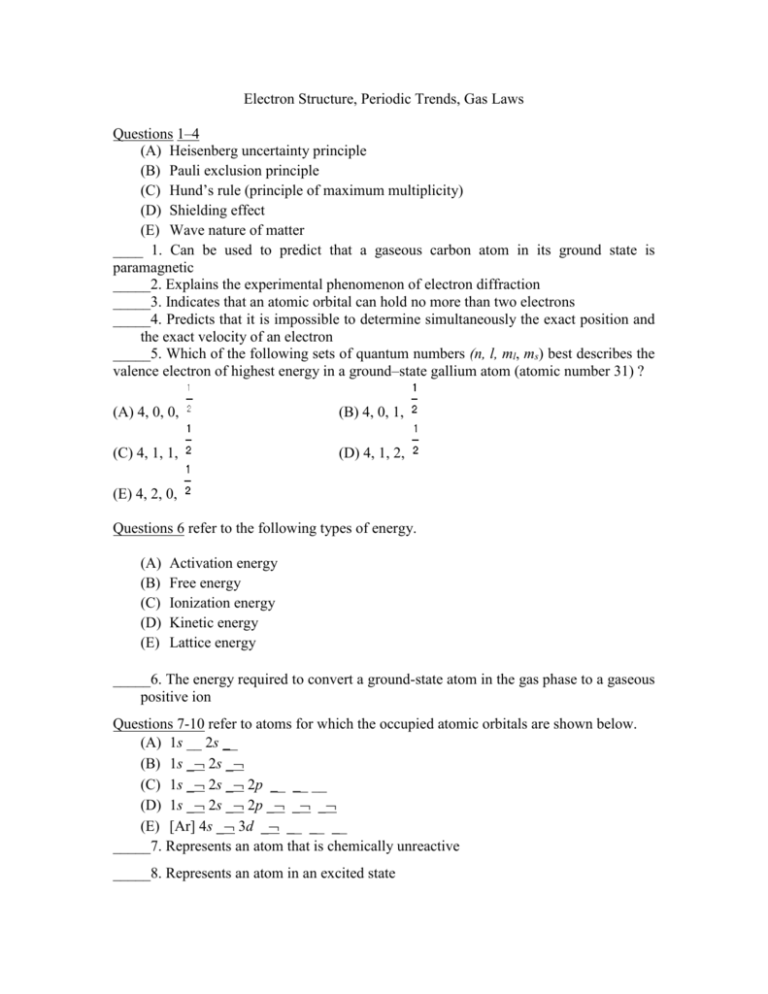Electron Structure, Periodic Trends, Gas Laws
advertisement

Electron Structure, Periodic Trends, Gas Laws Questions 1–4 (A) Heisenberg uncertainty principle (B) Pauli exclusion principle (C) Hund’s rule (principle of maximum multiplicity) (D) Shielding effect (E) Wave nature of matter ____ 1. Can be used to predict that a gaseous carbon atom in its ground state is paramagnetic _____2. Explains the experimental phenomenon of electron diffraction _____3. Indicates that an atomic orbital can hold no more than two electrons _____4. Predicts that it is impossible to determine simultaneously the exact position and the exact velocity of an electron _____5. Which of the following sets of quantum numbers (n, l, ml, ms) best describes the valence electron of highest energy in a ground–state gallium atom (atomic number 31) ? (A) 4, 0, 0, (B) 4, 0, 1, (C) 4, 1, 1, (D) 4, 1, 2, (E) 4, 2, 0, Questions 6 refer to the following types of energy. (A) (B) (C) (D) (E) Activation energy Free energy Ionization energy Kinetic energy Lattice energy _____6. The energy required to convert a ground-state atom in the gas phase to a gaseous positive ion Questions 7-10 refer to atoms for which the occupied atomic orbitals are shown below. (A) 1s __ 2s (B) 1s 2s (C) 1s 2s 2p __ (D) 1s 2s 2p (E) [Ar] 4s 3d _____7. Represents an atom that is chemically unreactive _____8. Represents an atom in an excited state _____9. Represents an atom that has four valence electrons _____10.Represents an atom of a transition metal Ionization Energies for element X (kJ mol-1) First Second Third Fourth Fifth 580 1,815 2,740 11,600 14,800 _____11. The ionization energies for element X are listed in the table above. On the basis of the data, element X is most likely to be (A)Na (B)Mg (C)Al (D) Si (E) P _____12. In the periodic table, as the atomic number increases from 11 to 17, what happens to the atomic radius? (A) It remains constant. (B) It increases only. (C) It increases, then decreases. (D) It decreases only. (E) It decreases, then increases. _____13. Which of the following is a correct interpretation of the results of Rutherford’s experiments in which gold atoms were bombarded with alpha particles? (A) Atoms have equal numbers of positive and negative charges. (B) Electrons in atoms are arranged in shells. (C) Neutrons are at the center of an atom. (D) Neutrons and protons in atoms have nearly equal mass. (E) The positive charge of an atom is concentrated in a small region Questions 14-16 a. O c. Rb e. N b. La d. Mg _____14. What is the most electronegative element? _____15. Which element exhibits the greatest number of different oxidation states? _____16. Which of the elements above has the smallest ionic radius for its most commonly found ion? Questions17-20 a. 1s2 2s22p5 3s23p5 b. 1s2 2s22p6 3s23p6 c. 1s2 2s22p62d10 3s23p6 d. 1s2 2s22p6 3s23p63d5 e. 1s2 2s22p6 3s23p63d3 4s2 _____17. An impossible electronic configuration _____18. The ground–state configuration for the atoms of a transition element _____19. The ground–state configuration of a negative ion of a halogen _____20. The ground–state configuration of a common ion of an alkaline earth element Questions 21-23 (A) F (C) Mg (E) Mn (B) S (D) Ar _____21. Forms monatomic ions with 2– charge in solutions _____22. Forms a compound having the formula KXO4 _____23. Forms oxides that are common air pollutants and that yield acidic solution in water _____24. 1s2 2s2 2p6 3s2 3p3 Atoms of an element, X, have the electronic configuration shown above. The compound most likely formed with magnesium, Mg, is (A) MgX (C) MgX2 (E) Mg3X2 (B) Mg2X (D) MgX3 _____25. The elements in which of the following have most nearly the same atomic radius? (A) Be, B, C, N (C)Mg,Ca,Sr,Ba (B) Ne, Ar, Kr, Xe (D)C,P,Se,I (E) Cr, Mn, Fe, Co _____26. The system shown above is at equilibrium at 28C. At this temperature, the vapor pressure of water is 28 millimeters of mercury. The partial pressure of O2(g) in the system is (A) 28 mm Hg (B) 56 mm Hg (C) 133 mm Hg (D) 161 mm Hg (E) 189 mm Hg _____27. A rigid metal tank contains oxygen gas. Which of the following applies to the gas in the tank when additional oxygen is added at constant temperature? (A) The volume of the gas increases. (B) The pressure of the gas decreases. (C) The average speed of the gas molecules remains the same. (D) The total number of gas molecules remains the same. (E) The average distance between the gas molecules increases. W+X→Y+Z 28 Gases W and X react in a closed, rigid vessel to form gases Y and Z according to the equation above. The initial pressure of W(g) is 1.20 atm and that of X(g) is 1.60 atm. No Y(g) or Z(g) is initially present. The experiment is carried out at constant temperature. What is the partial pressure of Z(g) when the partial pressure of W(g) has decreased to 1 .0 atm? (A) 0.20 atm (B) 0.40 atm (C) l.0 atm (D) 1.2 atm (E) l.4 atm NH4NO3(s) → N2O(g) + 2 H2O(g) _____29. A 0.03 mol sample of NH4NO3(s) is placed in a 1 L evacuated flask, which is then sealed and heated. The NH4NO3(s) decomposes completely according to the balanced equation above. The total pressure in the flask measured at 400 K is closest to which of the following? (The value of the gas constant, R, is 0.082 L atm mol-1 K1 .) (A) 3 atm (B) 1 atm (C) 0.5 atm (D) 0.1 atm (E) 0.03 atm _____30. Equal numbers of moles of He(g), Ar(g), and Ne(g) are placed in a glass vessel at room temperature. If the vessel has a pinhole-sized leak, which of the following will be true regarding the relative values of the partial pressures of the gases remaining in the vessel after some of the gas mixture has effused? (A) PHe < PNe < PAr (B) PHe < PAr < PNe (C) PNe < PAr < PHe (D) PAr < PHe < PNe (E) PHe = PAr = PNe _____31. Which of the following gases deviates most from ideal behavior? (A) SO2 (B) Ne (C) CH4 (D) N2 (E)H2








